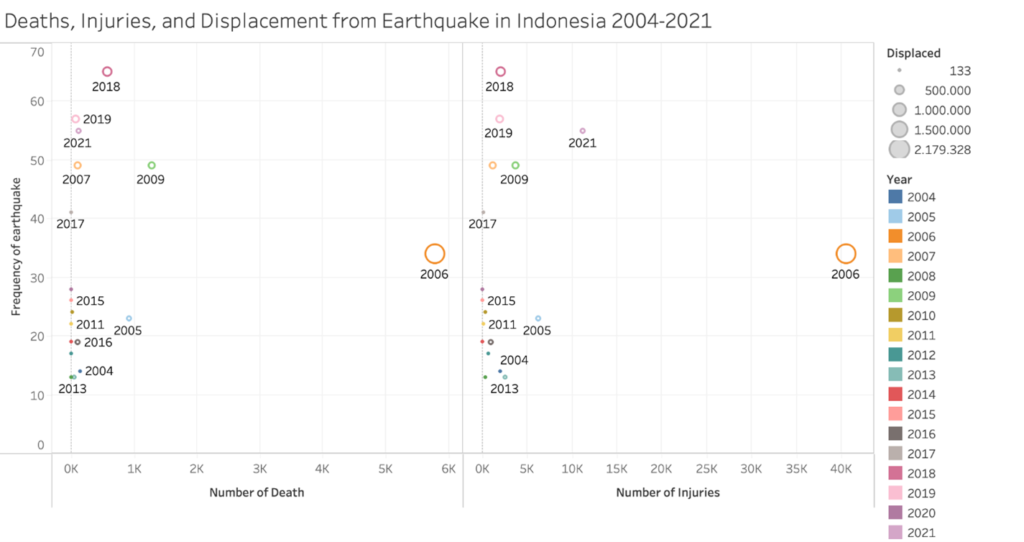
By Krisna Puji Rahmayanti, Doctoral Researcher, International Development Department, University of Birmingham
On November 21, 2022, a magnitude 5.6 earthquake struck Cianjur Regency, a city in West Java Province, Indonesia. Following the earthquake in Cianjur, several aftershocks occurred, including those in Garut and Cianjur Regencies, and Sukabumi Regency.

Indonesia’s vulnerability to this disaster places the country among the world’s most earthquake-prone countries. A magnitude 7.3 earthquake struck Cianjur Regency more than a decade ago, killing 28, leaving 42 people missing, injuring 21, and displacing 10,047 people.
2022’s earthquake has a much more severe impact, with 327 people killed, 13 people missing, and 108,720 displaced, according to the government’s report. According to the graph, earthquakes are one type of disaster that has resulted in thousands of casualties year after year. The graph excludes the two earthquakes followed by the tsunami that caused the Indian Ocean Tsunami in 2004, which killed 128,858 people and the Palu Tsunami in 2018, which killed 3,674.
The recurrence of earthquakes and other disasters in Indonesia requires the government, particularly local governments, to be more responsive and collaborative in disaster management. Following the reform, Indonesia’s governance shifted to decentralise governance, transferring several authorities to local governments, including disaster management authority so that disasters can be responded on city level. The Cianjur Regency earthquake was declared a regional disaster giving local governments authority to respond, with support of central government where assistance was required.
Local Government Capacity and Community Resilience
Local governments must have internal capacity to respond to disasters. Research on local government capacity in disaster management has long emphasised the importance of maintaining government capability in Indonesia in handling disaster. The government’s capacity for disaster management must be understood as a community capacity to promote resilience. Various aspects of a city’s resilience are indicators, including governance and legislation, financial capacity, urban development, environment and ecosystem management, institutional capacity, critical infrastructure and basic service delivery law. The Cianjur Regency earthquake shows that the availability of a budget becomes critical in responding to disasters. The presence of comprehensive disaster management, as well as efforts to increase public apparatus and local community awareness, may also increase the community’s readiness.
The increasing use of social media in Indonesia makes local disaster response as a national spotlight. A few days after the earthquake in Cianjur, the national media shared a story on the emergence of viral videos. These videos included content on the issue of aid blocking on the road, criticisms over the delivery of instant noodles, concerns about too over-delivery of used clothes, and a heated Twitter debate about incidents of organisations removing labels of churches from victim’s tents.
In response to a video about the amount of noodles sent as aid, the National Agency for Disaster Management explained that the supply for aid for victims is varied and not limited to instant noodles. Ridwan Kamil, the Governor of West Java Province, also stated that communities should coordinate with the government’s structure to access assistance and urged aid providers to coordinate with the Government’s Command Center to avoid problems with aid delivery. The incident of mass organisation that remove the label of the church in the victim’s tent sparked debate on Twitter and the Indonesian Ulema Council asked the citizen to avoid sensitive issue related to religion and politics, in aid’s distribution and helping each other despite different religions. This situation demonstrates that the government’s ability to respond to disasters is critical and that the community and non-governmental organisations involved must also follow disaster response commands and consider the value of each aid recipient.
Collaborative Capacity
Cross-sectoral collaboration in Indonesia in responding to disasters seems to be getting more robust, and every local government must now have a networking capacity. The paradigm shift from non-involvement strategies to coordination policies and collaborative governance, provides a practical foundation for various actors to participate in disaster management. The Sendai Framework for Disaster Risk Reduction urge to embrace cooperation and partnership. Currently, the government is promoting a disaster mitigation forum at each level of government. However, this forum should be more than just an administrative requirement; it should also serve as a learning and coordination forum. The preparedness of each local government’s network of institutions can increase the resilience of each city in the face of various disasters.
Looking forward
As the magnitude of disasters increase at the local level, local governments must expand their capacity. Internal and collaborative capacity are essential for managing the impact of disasters and collaborating with other institutions in disaster response. Resilient communities also demonstrate that the disaster response process necessitates not only bureaucratic readiness in responding, but also community maturity in managing crises caused by disasters.
- Find out more about Krisna Puji Rahmayanti
- More about the International Development Department at the University of Birmingham
- Back to Social Sciences Birmingham
The views and opinions expressed in this article are those of the author and do not necessarily reflect the official policy or position of the University of Birmingham.
